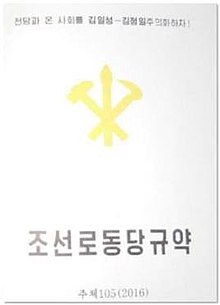
Rules of the Workers' Party of Korea

| Rules of the Workers' Party of Korea | |
 Title page of the current Rulebook of the Workers' Party of Korea | |
| Korean name | |
|---|---|
| Chosŏn'gŭl | 조선로동당규약 |
| Hancha | 朝鮮勞動黨規約 |
| Revised Romanization | Joseon rodongdang gyuyak |
| McCune–Reischauer | Chosŏn rodongdang kyuyak |
 |
|---|
|
|
The Rules of the Workers' Party of Korea (Korean: 조선로동당규약; MR: Chosŏn rodongdang kyuyak) are the by-laws of the Workers' Party of Korea (WPK). It sets the rules of the organization and membership of the party. According to the rules, the WPK Congress is the highest body of the party and it, along with the WPK Conference, can amend the rules. The rules defines the character, task, and methodology of the party. According to it, the Party strives to impose communism on the whole of the Korean Peninsula. Recent revisions of the rules have defined Kimilsungism–Kimjongilism as the ideology of the party.

The first rules were adopted on 30 August 1946 at the 1st Congress of the Workers' Party of North Korea, the immediate predecessor of the modern WPK. Since then, every Conference and some Congresses have revised the rules, most recently the 7th Congress in 2016.

Since the death of Kim Il Sung and Kim Jong Il's accession to the leadership of the country, the rules has not been adhered to by the party. After the 6th Congress in 1980, Congresses were no longer held every five years as stipulated by the rules. Neither were plenums of the Central Committee held at regular six month intervals. Kim Jong Il was also elected General Secretary of the party without observing the correct procedure. In preparation of Kim Jong Un's succession, the 3rd Conference in 2010 revised the rules to ensure that he would secure leadership in both the party and the army at the same time. Changes were also made to allow the Kim dynasty to pick a dates for Congresses freely. Such a Congress, 8th party Congress, amended the rules by giving Kim Jong Un the title General Secretary of the Workers' Party of Korea in January 2021.[1]

Purpose
The rules, commonly known as the "Rules and Constitution", contains the party's by-laws.[2] The rules outlines the character, task and methodology of the Worker's Party.[3] It sets communism across the whole Korean Peninsula as the goal of the party.[4] According to the rules, the party "represents the interests of the Korean nation and people", and its immediate task is "to attain a perfect victory of socialism in the northern part and to complete the revolutionary tasks of achieving national liberation and the people's democracy through the country." This task is to be achieved by "perform[ing] the revolution and construction tasks under the sole leader's exclusive guidance, applying his revolutionary ideology as [the] guideline".[3] The rules stipulates that the party guides all state and social organs in North Korea.[5]

The rules sets the rules on the organization of the party and its membership. It stipulates that the Congress is the highest body of the party. The rules says that when the Congress is not in session, the party is run by the Central Committee. According to the rules, the Central Committee elects the General Secretary of the party, members of the Politburo, its Presidium, the Executive Policy Bureau, members of the Control Commission, and members of the Central Military Commission (CMC).[6][7]

The rules can be amended by a Congress or a Conference of the party.[8][9] The Control Commission theoretically probes suspected violations of the rules by party members.[8] However, the rules is, in fact, an essentially meaningless document for much of its existence, since there is no oversight of central-level compliance.[10] Despite this, NK News has called the party rules "one of the most important texts in North Korea's political system".[11]

Implementation
Although the rules is the party's highest document de jure, Kim Il Sung and Kim Jong Il breached party protocol during their rule by not convening party Congresses or Central Committee plenums.[12] The Central Committee is not a permanent body; it must convene, according to the party's rules, at least once every six months. The Central Committee is, according to the party's rules, elected by delegates to a party congress; in practice, however, this has not been the case.[13]

According to Article 27 of the rules, the Central Military Commission (CMC) is the highest party body in military affairs; it commands the Korean People's Army, developing and guiding its weaponry.[14] In practice, however, the CMC is a ceremonial body subordinate to the National Defence Commission.[14] A 1982 amendment to the rules is believed to have made the CMC equal to the Central Committee, enabling it (among other things) to elect the party leader.[15]

Although the party rules specifies that the Politburo should meet at least once a month, there is little evidence that this has actually happened.[16]

In 2010 the rule that Congresses be held every five years was dropped, recognising this had been ignored for thirty years.[17]

History
The first rules was adopted on 30 August 1946 in the 1st Congress of the Workers' Party of North Korea, the immediate predecessor of the present WPK. The 2nd Congress revised it on 30 March 1948, and the 3rd Congress of the Workers' Party of Korea made extensive revisions to it in April 1956. The 4th Congress amended it on 18 September 1961, and the 5th Congress on 13 November 1970. The 6th Congress revised it on 10 October 1980.[18]

The 1990s (especially after Kim Il Sung's death) began a period in which any pretense of following the rules was dropped.[19] No Central Committee plenums were convened between 1993 and 2010,[20] even though the rules mandated one to be held at least every six months.[13] As consequence, the composition of the CC at that time remained only an estimate. It was not known which members of the 6th CC were active or even alive.[12]

In a clear breach of the rules, Kim Jong Il was appointed WPK General Secretary in a joint announcement by the 6th Central Committee and the CMC rather than elected by a plenum of the Central Committee.[21]

3rd party Conference
On 26 June 2010 the Politburo announced that it was summoning delegates for the 3rd party Conference,[20] with its official explanation the need to "reflect the demands of the revolutionary development of the Party, which is facing critical changes in bringing about the strong and prosperous state and chuche [Juche] development."[20] The Conference met on 28 September, revising the party rules and electing (and dismissing) members of the Central Committee, the Secretariat, the Politburo, the Presidium and other bodies.[20] The WPK's ultimate goal was changed from "build[ing] a communist society" (although Marxism–Leninism was still mentioned)[22] to "embody[ing] the revolutionary cause of Juche in the entire society".[22]

The rules was revised at the 3rd Conference (its first revision since the 6th Congress in 1980)[12][23] to require the party's First Secretary to also hold the office of Chairman of the party's Central Military Commission.[9] This was to ensure Kim Jong Un's succession of his father, Kim Jong Il, by guaranteeing that he inherits the top posts in not just the party but the army as well.[24]

Although a congress was formerly mandated to be convened every five years, the 3rd Conference revised the party rules to state that the Central Committee could convene a congress as desired with six months' notice to the party.[22] This, too, was done in preparation for Kim Jong Un's succession, allowing the Kim dynasty to pick the date freely.[25]

Two new articles were added: "The Party and the People's Power" and "The Party Logo and Flag of Party".[26]

4th party Conference
Ideology was elaborated at the 4th party Conference in 2012, when Kimilsungism–Kimjongilism became "the only guiding idea of the party" in the rules.[27]

7th party Congress
At the 7th party Congress on 9 May 2016, the rules was amended "as required by the developing reality."[7] The dual-track policy of pursuing both economic growth and nuclear weapons capacity was added to the Charter.[28] Secretary titles were made Chairmen and Vice-Chairmen in both the central and municipal levels. The Secretariat was named the Executive Policy Bureau. The First Secretary of the party became Chairman of the Workers' Party.[7]

8th party Congress
The 8th party Congress held in 2021 again amended the party rules. It changed the leader of the party from Chairman to General Secretary, established a post called First Secretary, mostly removed mentions of Kim Il Sung, Kim Jong Il and Kim Jong Un, removed a line calling for a revolution in South Korea, and reasserted its commitment to communism.[29][11]

See also
- Constitution of North Korea
- Law of North Korea
- Politics of North Korea
- Ten Principles for the Establishment of a Monolithic Ideological System
References
- ^ 朝鮮労働党規約(2021年1月9日改正・抜粋訳) 1/3. KoreaWorldTimes (in Japanese). 5 June 2021. Retrieved 6 June 2021.
- ^ "Meeting of Party Cell Secretaries To Be Held in Pyongyang". North Korea Leadership Watch. 18 January 2014. Retrieved 12 March 2013.
- ^ a b North Korea Handbook 2002, p. 93.
- ^ North Korea Handbook 2002, p. 651.
- ^ Gause 2013, p. 19.
- ^ Andrea Matles Savada, ed. (1993). "North Korea - The Korean Workers' Party (KWP)". North Korea: A Country Study. Washington: GPO for the Library of Congress. Retrieved 9 May 2016.
{{cite book}}:|work=ignored (help) - ^ a b c "Fourth and Final Day of the 7th Party Congress". North Korea Leadership Watch. 10 May 2016. Retrieved 25 May 2016.
- ^ a b North Korea Handbook 2002, p. 94.
- ^ a b "4th Party Conference To Convene in "mid-April"". North Korea Leadership Watch. 2 February 2012. Retrieved 12 March 2013.
- ^ Gause 2013, p. 28.
- ^ a b "Everything you need to know about North Korea's new Party rules". NK PRO. 10 June 2021. Retrieved 28 August 2022.
- ^ a b c "3rd Party Conference". North Korea Leadership Watch. 3 September 2010. Retrieved 12 March 2014.
- ^ a b Lankov 2007, p. 66.
- ^ a b Gause 2011, pp. 226–227.
- ^ Gause 2013, p. 43.
- ^ Buzo 1999, p. 31.
- ^ "North Korean Party Congress Primer". 38 North. The Henry L. Stimson Center. 20 December 2020. Retrieved 6 January 2021.
- ^ Il-pyong J. Kim (1984). "Introduction [The Statute of the Korean Workers' Party]". In Simons, William B.; White, Stephen (eds.). The Party Statutes of the Communist World. The Hague: Martinus Nijhoff Publishers. p. 263. ISBN 90-247-2975-0.
- ^ Kim 2000, p. 257.
- ^ a b c d Gause 2013, p. 20.
- ^ Gause 2011, p. 18.
- ^ a b c Gause 2011, p. 147.
- ^ Gause 2013, p. 44.
- ^ "Power Shift Detailed in North Korean Party Charter". VOA. 21 January 2011. Retrieved 8 May 2016.
- ^ "[News Briefing] N. Korea reported to amend WPK charter for power succession". The Hankyoreh. 7 January 2011. Retrieved 8 May 2016.
- ^ "DPRK's WPK conference issues resolution on revision of party charter". Xinhua. 29 September 2010. Archived from the original on 3 October 2010. Retrieved 12 March 2014.
- ^ "Kimilsungism-Kimjongilism Reported by Chinese TV". KCNA. 27 May 2012. Archived from the original on 12 October 2014. Retrieved 8 May 2016.
- ^ Kang Jin-kyu (11 May 2016). "Kim Jong-un is made chairman of Workers' Party". Korea JoongAng Daily. Retrieved 25 May 2016.
- ^ 권, 영전 (1 June 2021). [표] 북한 노동당 규약 주요 개정 내용. 연합뉴스 (in Korean). Retrieved 28 August 2022.
Works cited
- Buzo, Adrian (1999). The Guerilla Dynasty: Politics and Leadership in North Korea. I.B. Tauris. ISBN 1-86064-414-7.
- Gause, Ken E. (2011). North Korea Under Kim Chong-il: Power, Politics, and Prospects for Change. ABC-CLIO. ISBN 978-0-313-38175-1.
- — (2013). "The Role and Influence of the Party Apparatus". In Park, Kyung-ae; Snyder, Scott (eds.). North Korea in Transition: Politics, Economy, and Society. Rowman & Littlefield. pp. 19–46. ISBN 978-1-4422-1812-3.
- Kim, Samuel (2000). "North Korean Informal Politics". Informal Politics in East Asia. Cambridge University Press. ISBN 0-521-64538-7.
- Lankov, Andrei (2007). Crisis in North Korea: The Failure of De-Stalinization, 1956. University of Hawaii Press. ISBN 978-0-8248-3207-0.
- North Korea Handbook. Seoul: Yonhap News Agency. 2002. ISBN 978-0-7656-3523-5.
Further reading
- WPNK (1946). "[Charter of the Workers' Party of North Korea]". Pukchoson Nodon-dang Ch'angnip Taehoe [Founding Congress of the North Korean Workers' Party] (in Korean). Pyongyang. pp. 48–56.
{{cite book}}: CS1 maint: location missing publisher (link) - — (1948). "[Charter of the Workers' Party of North Korea]". Pukchoson Nodon-dang Cheich'a Chondang Taehoe Hoeirok [Proceedings of the Second Congress of the North Korean Workers' Party] (in Korean). Pyongyang. pp. 191–213.
{{cite book}}: CS1 maint: location missing publisher (link) - WPK (1956). "[Charter of the Workers' Party of Korea]". Third Congress of the Workers' Party of Korea: Documents and Materials, April 23-29, 1956. Pyongyang: Foreign Languages Publishing House. pp. 387–405. OCLC 51325071.
- — (1956–1961). "Rules of the Workers' Party of Korea: As amended on April 28, 1956 and September 16, 1961". In Scalapino, Robert A.; Chong-Sik Lee (eds.). Communism in Korea: The Society. Berkeley: University of California Press (published 1972). pp. 1331–1349. ISBN 978-0-520-02274-4.
- — (1970). "[Charter of the Workers' Party of Korea]". In Dae-Sook Suh (ed.). Korean Communism 1945-1980: A Reference Guide to the Political System. Honolulu: University Press of Hawaii (published 1981). pp. 525–544. ISBN 978-0-8248-0740-5.
- — (1980). "The Statute of the Korean Workers' Party: Approved by the VI (1980) Congress of the KWP". In Simons, William B.; White, Stephen (eds.). The Party Statutes of the Communist World. Translated by Il-pyong J. Kim. The Hague: Martinus Nijhoff Publishers (published 1984). pp. 265–284. ISBN 90-247-2975-0.
- — (2010). 조선로동당규약 [Charter of the Workers' Party of Korea] (PDF) (in Korean). Archived from the original (PDF) on 22 June 2017. Retrieved 8 May 2016.
See what we do next...
OR
By submitting your email or phone number, you're giving mschf permission to send you email and/or recurring marketing texts. Data rates may apply. Text stop to cancel, help for help.
Success: You're subscribed now !


